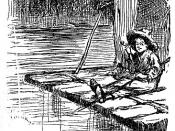How the passage conveys a theme:
Through vivid imagery, situational irony, and a powerful emotional sequence, Twain gives the reader a memorable scene, one which conveys a powerful theme. Essentially, we see Jim, apparently a loving father, not even knowing his own daughter; he doesn't realize she is deaf and thus sends her "a-sprawlin'" across the room when she doesn't obey his command of shutting the door. It is situational irony; a person supposed to know this little girl the best doesn't at all. More importantly, Twain crafts the scene in a way that makes the reader slow down when he reads it; this is powerful as it allows the reader to focus on the vivid imagery of the scene. We see Jim busting out crying, grabbing his little daughter in his arms, regretting his actions and repenting for his sins. This imagery focuses on a major theme--Jim, a slave, has feelings too.
Thus, in Jim's narrative, Huck begins to see that even though he is a slave, Jim has strong familial ties and powerful emotions, and this is possibly a turning point in the novel regarding Huck and Jim's relationship. Twain accomplishes all of this in a simple, yet very emotionally powerful narrative.
Message it sends to Twain's reader of 1884:
Although slavery had been abolished by 1884, racism still existed. By portraying Jim with feelings (he was extremely sad and regretted slapping his daughter), Twain suggests that African-Americans are completely equal to whites. This is an eye opening passage, and Twain utilizes a sad narrative to show the reader of 1884 that blacks are equal to whites--not just that they should be by law, but that they really are, and he uses Jim's emotion to show this.
Message it creates for...


